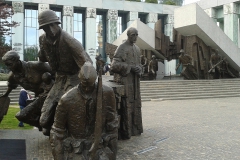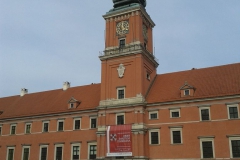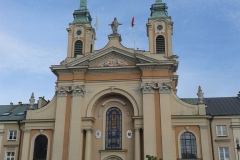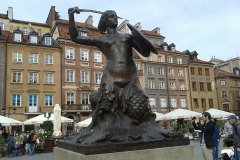 The Warsaw Uprising was a major World War II operation by the Polish resistance Home Army (Armia Krajowa) to liberate Warsaw from Nazi Germany. The Uprising was timed to coincide with the Soviet Union's Red Army approaching the eastern suburbs of the city and the retreat of German forces. However, the Soviet advance stopped short, enabling the Germans to regroup and demolish the city while defeating the Polish resistance, which fought for 63 days with little outside support. The Uprising was the largest single military effort taken by any European resistance movement during World War II. Warsaw was demolished in 85%.
25% as a result of the Uprising, 35% as a result of systematic German actions after the uprising, and the rest as a result of the earlier Warsaw Ghetto Uprising, and the September 1939 German invasion campaign. Material losses are estimated at 10,455 buildings, 923 historical buildings (94%), 25 churches, 14 libraries including the National Library, 81 primary schools, 64 high schools, University of Warsaw and Warsaw University of Technology, and most of the historical monuments. Almost a million inhabitants lost all of their possessions. (Wikipedia).
After the end of the Warsaw Uprising all remaining inhabitants were pushed out of the ruins of Warsaw. Many of them ended in German concentration camps. After the II World War Soviet Union established communism in Poland and blocked former inhabitants of Warsaw to return to their homes.
The Warsaw Uprising was a major World War II operation by the Polish resistance Home Army (Armia Krajowa) to liberate Warsaw from Nazi Germany. The Uprising was timed to coincide with the Soviet Union's Red Army approaching the eastern suburbs of the city and the retreat of German forces. However, the Soviet advance stopped short, enabling the Germans to regroup and demolish the city while defeating the Polish resistance, which fought for 63 days with little outside support. The Uprising was the largest single military effort taken by any European resistance movement during World War II. Warsaw was demolished in 85%.
25% as a result of the Uprising, 35% as a result of systematic German actions after the uprising, and the rest as a result of the earlier Warsaw Ghetto Uprising, and the September 1939 German invasion campaign. Material losses are estimated at 10,455 buildings, 923 historical buildings (94%), 25 churches, 14 libraries including the National Library, 81 primary schools, 64 high schools, University of Warsaw and Warsaw University of Technology, and most of the historical monuments. Almost a million inhabitants lost all of their possessions. (Wikipedia).
After the end of the Warsaw Uprising all remaining inhabitants were pushed out of the ruins of Warsaw. Many of them ended in German concentration camps. After the II World War Soviet Union established communism in Poland and blocked former inhabitants of Warsaw to return to their homes.
 The Warsaw Uprising was a major World War II operation by the Polish resistance Home Army (Armia Krajowa) to liberate Warsaw from Nazi Germany. The Uprising was timed to coincide with the Soviet Union's Red Army approaching the eastern suburbs of the city and the retreat of German forces. However, the Soviet advance stopped short, enabling the Germans to regroup and demolish the city while defeating the Polish resistance, which fought for 63 days with little outside support. The Uprising was the largest single military effort taken by any European resistance movement during World War II. Warsaw was demolished in 85%.
25% as a result of the Uprising, 35% as a result of systematic German actions after the uprising, and the rest as a result of the earlier Warsaw Ghetto Uprising, and the September 1939 German invasion campaign. Material losses are estimated at 10,455 buildings, 923 historical buildings (94%), 25 churches, 14 libraries including the National Library, 81 primary schools, 64 high schools, University of Warsaw and Warsaw University of Technology, and most of the historical monuments. Almost a million inhabitants lost all of their possessions. (Wikipedia).
After the end of the Warsaw Uprising all remaining inhabitants were pushed out of the ruins of Warsaw. Many of them ended in German concentration camps. After the II World War Soviet Union established communism in Poland and blocked former inhabitants of Warsaw to return to their homes.
The Warsaw Uprising was a major World War II operation by the Polish resistance Home Army (Armia Krajowa) to liberate Warsaw from Nazi Germany. The Uprising was timed to coincide with the Soviet Union's Red Army approaching the eastern suburbs of the city and the retreat of German forces. However, the Soviet advance stopped short, enabling the Germans to regroup and demolish the city while defeating the Polish resistance, which fought for 63 days with little outside support. The Uprising was the largest single military effort taken by any European resistance movement during World War II. Warsaw was demolished in 85%.
25% as a result of the Uprising, 35% as a result of systematic German actions after the uprising, and the rest as a result of the earlier Warsaw Ghetto Uprising, and the September 1939 German invasion campaign. Material losses are estimated at 10,455 buildings, 923 historical buildings (94%), 25 churches, 14 libraries including the National Library, 81 primary schools, 64 high schools, University of Warsaw and Warsaw University of Technology, and most of the historical monuments. Almost a million inhabitants lost all of their possessions. (Wikipedia).
After the end of the Warsaw Uprising all remaining inhabitants were pushed out of the ruins of Warsaw. Many of them ended in German concentration camps. After the II World War Soviet Union established communism in Poland and blocked former inhabitants of Warsaw to return to their homes.



